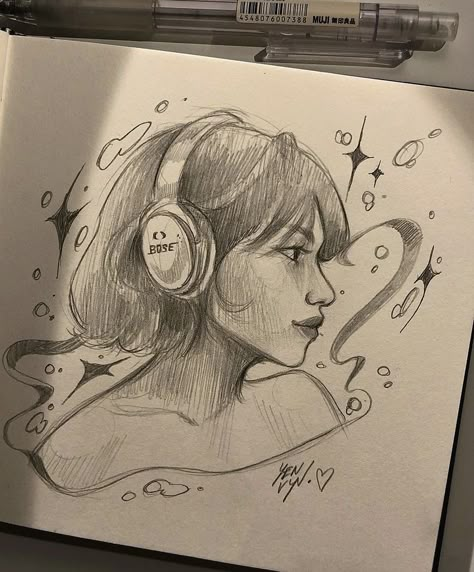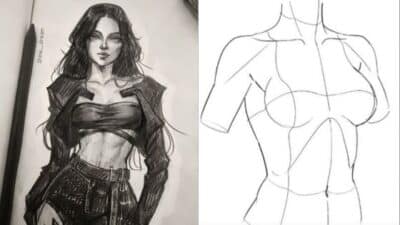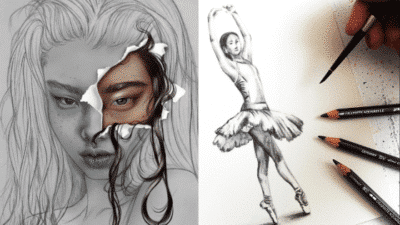Feeling stuck on what to draw can happen to anyone, whether you’re new to art or looking to boost your creative routine. This post will help you discover a variety of simple and creative drawing ideas, making it easier to start your next project and enjoy the process. You don’t need elaborate supplies or advanced skills—just some basic tools and an open mind.
You’ll find easy inspirations and practical tips that can lead to fun sketches, unique drawings, and steady improvement over time. Get ready to bring your ideas to life, using both your imagination and the world around you for fresh subjects.



Key Takeaways
- Find drawing ideas to get inspired and break creative blocks
- Learn simple approaches and techniques for enjoyable practice
- Use everyday materials and subjects to spark creativity
Fundamental Drawing Techniques
Strong drawing starts with understanding how to control your materials and train your observation. Building drawing skills means practicing a few essential techniques that help you create well-structured and expressive art.
Mastering Line and Shape
Creating confident lines is the first step in most drawings. Use pencils, pens, or even ink to explore line quality, including straight, curved, thick, and thin lines. Try exercises like contour drawing to improve control and hand-eye coordination.
Shapes are the building blocks of complex forms. Start with basic geometric shapes—spheres, cubes, cylinders, and cones. Combine these to sketch objects quickly or map out proportions before adding details.
Tips for mastering line and shape:
- Use quick gestures for initial sketches.
- Vary pressure on your tool for different effects.
- Trace over your lines to adjust and refine.
- Keep your wrist loose for smoother curves.
Exploring Value and Texture
Value describes how light or dark something appears in your drawing. Practicing value scales with pencils or charcoal helps you improve shading. Blend gently for smooth transitions, or use cross-hatching with pen or ink for a textured look.
Textures add interest and detail. To capture different surfaces, try using stippling, scribbling, or varied eraser marks. Study how fabric, wood, or metal look and experiment with matching those effects.
Value and texture essentials:
| Technique | Tool Suggestions | Purpose |
|---|---|---|
| Hatching | Pen, Pencil, Ink | Add form and dimension |
| Blending | Charcoal, Pencil | Smooth gradients |
| Stippling | Pen, Ink | Create grainy/light textures |
Understanding Form and Space
Form involves making objects appear three-dimensional. Shade with attention to light source and use value changes to suggest highlights and shadows. Observing real objects under light can help you understand this better.
Space refers to how you show depth and distance in a drawing. Use perspective techniques like vanishing points for architecture, and overlap objects to show which are closer or farther away.
Key points for form and space:
- Block in objects with basic shapes first.
- Use line weight and shading for depth.
- Practice both one-point and two-point perspective drawing.
Use charcoal for bold forms or pencils for refined space details. With practice, you’ll notice more structure and realism in your art.



Essential Drawing Tools and Materials
Selecting the right drawing tools can make your creative process smoother and help your ideas come alive. Materials like pencils, pens, sketchbooks, and color mediums are all important for different drawing techniques and styles.
Choosing the Right Pencils and Pens
For sketching, it’s helpful to have a range of graphite pencils such as 4H, 2H, HB, 2B, and 4B. Hard pencils (H) are great for light lines and details, while softer pencils (B) create darker shades for shading and contrast. Popular brands to try include Derwent and Faber-Castell.
Mechanical pencils can be handy for precise lines and don’t require sharpening. When it comes to pens, fineliners, brush pens, and gel pens offer crisp outlines and varying line thicknesses. Waterproof and fade-resistant ink is best if you plan to add color later. Consider this table for quick comparison:
| Tool | Best Use | Notable Features |
|---|---|---|
| Graphite Pencil | Sketching, shading | Different grades available |
| Mechanical Pencil | Fine details | Consistent line width |
| Fineliner Pen | Outlines, inking | Waterproof ink |
| Brush Pen | Expressive line work | Flexible tip |
Best Sketchbooks for Creative Ideas
Choosing a good sketchbook depends on your style and preferred media. For dry media like pencil and pen, look for sketchbooks labeled as acid-free with medium to heavyweight paper (70–100 lb or 110–150 gsm). Spiral-bound sketchbooks allow for flat drawing and easy page removal.
Popular sizes include 5.5”x8.5” for portability and 9”x12” for larger ideas. Brands like Strathmore and Moleskine are well reviewed for their paper quality. If you enjoy working with wet media like marker or watercolor, pick mixed-media or watercolor sketchbooks with thicker, textured pages to prevent warping.
A small pocket sketchbook can help you capture quick ideas on the go. Some artists also enjoy toned paper, which provides a mid-value base for highlights and shadows.
Exploring Color and Watercolor Uses
Adding color can transform sketches into finished pieces. Colored pencils, alcohol-based markers, and watercolor palettes each offer unique effects. Prismacolor and Faber-Castell colored pencils blend smoothly for layering and shading.
Watercolor paints let you add soft washes or vibrant accents. Use a sketchbook designed for watercolor to prevent buckling and keep colors vibrant. Try using waterproof pens for line work, so the ink doesn’t bleed when water is applied.
To experiment with new styles, dedicate a few pages for color testing and practice strokes. Having quality brushes and blending tools can make a big difference when working with watercolor and mixed media.



Creative Drawing Ideas for Inspiration
Great drawing ideas can make art feel fresh and approachable, whether you’re picking up your pencil for the first time or just looking to spark your creative juices. Mixing easy prompts, imaginative themes, and unique techniques helps you build both skill and confidence.
Easy Drawing Ideas to Try
If you want to draw but aren’t sure where to start, simple prompts are a great entry point. Try sketching basic objects like cups, fruit, keys, or shoes. These common items let you practice proportions and shading without getting overwhelmed.
Using a five-minute timer can add a fun challenge. Quick studies—like drawing your hand, an open book, or your favorite snack—help you loosen up. You might also create a grid in your sketchbook and fill each square with a different pattern or quick doodle.
List of easy drawing ideas:
- A stack of books
- Your pet curled up
- Houseplants or leaves
- A single flower
- Shapes overlapping and casting shadows
Drawing from observation, no matter how simple the subject, helps you build eye-hand coordination and see details you might not notice otherwise.
Imaginative Prompts for Creative Juices
Sometimes, all you need is a playful challenge to boost your creativity. Try giving yourself imaginative prompts such as:
- “Draw what happiness looks like.”
- “Invent a new animal by combining two real animals.”
- “Illustrate a dream you had last night.”
Prompt yourself with scenarios, such as “What would your morning coffee cup look like if it could talk?” or “Design a futuristic city skyline.” Limiting your color palette or medium can encourage creative solutions and fresh ideas.
You can also keep a small notebook for drawing prompts and brainstorms. This keeps your ideas handy for days when inspiration feels out of reach. Mixing real life with fantasy often leads to unique, unexpected results that help your art stand out.
Unique Still Life Drawing Ideas
Still life drawing doesn’t have to be traditional or boring. Challenge yourself by arranging unusual combinations of objects—try mixing technology items with natural elements, such as placing headphones beside a flower vase.
Experiment with different perspectives, like drawing your scene reflected in a mirror or seen through a glass of water. Use a desk lamp to cast dramatic shadows and practice shading. Draw your favorite snack in different stages: unwrapped, half-eaten, and finished.
You might arrange objects based on a theme, such as “travel” (a passport, postcards, sunglasses) or “kitchen” (spices, utensils, a tea mug). This variety pushes you to notice textures, shapes, and light, refining your drawing skills with every new setup.
Fun Doodle and Embroidery Art Ideas
Doodling is a great way to relax and practice line work. Try filling the margins of your notebook with small patterns, simple faces, or quirky creatures. Create a “doodle board” for weekly themes, such as underwater scenes or outer space.
Fun doodle prompts:
- Mix unexpected items, like a cactus with sunglasses
- Combine everyday objects into imaginative hybrids
- Draw tiny repeating motifs, like stars or keys
Take inspiration from embroidery and crafts by designing patterns that would look good stitched. Draw floral borders, ornate initials, or simple geometric shapes that could be used in embroidery hoops.
Experiment with texture and bold outlines, using colored pencils to play with saturated colors. Whether doodling or imagining your drawings as embroidery, these art ideas keep your creativity flowing in a relaxed, playful way.



Drawing from Real Life and Imagination
Drawing from both what you see and what you imagine can help you build a strong foundation in art. Developing observational skills and exploring your imagination offer different benefits that work well together.
Capturing Everyday Objects
When you draw real-life objects, you train your eye to notice subtle details and improve your sense of proportion and perspective. Try sketching objects from your room, things on your to-do list, or items you use daily.
Set up simple still lifes with cups, shoes, or plants. Experiment with different lighting and angles to see how shadows and reflections change. Draw your object from multiple perspectives to understand its form.
Quick tip: Make a table of shapes, shading, and textures you observe. For instance:
| Object | Shape | Main Shadow | Texture |
|---|---|---|---|
| Mug | Cylinder | Under the handle | Smooth |
| Leaf | Oval | One side, beneath | Veined |
| Glass Jar | Cylinder | Base, inside curve | Shiny/clear |
This kind of practice can make your drawings more realistic and help you see ordinary items in a new light.
Drawing Yourself and Caricatures
Drawing yourself—whether as a self-portrait from a mirror or a playful caricature—strengthens your observation and expression skills. Look carefully at your face, paying attention to proportions and unique features.
Using a mirror allows you to observe subtle changes in light, shadow, and expression. For self-portraits, sketch your reflection from different angles over multiple sessions. This helps deepen your understanding of facial structure and how emotions show.
Caricatures are a fun way to exaggerate and simplify. Emphasize certain traits, like big glasses or a curly hairstyle, to convey personality. Try making a list of features that stand out when drawing yourself as a character. This technique also links to drawing figures with more stylized or creative flair.
Creating Dreamlike Scenes
Imagination gives you freedom to combine elements, invent backdrops, and bring stories to life. Let your mind wander to favorite fairy tales, dreams, or unreal places.
Begin by sketching a setting or scene—a castle in a forest, a city floating above the clouds, or a version of your room inspired by a dream. Use references from your daily experience as a base, then alter colors, scale, or perspective to fit your vision.
Try using lists or mind maps to plan out the parts of your scene. For example, jot down props from a fairy tale, moods from a dream, or unexpected items from your to-do list. Arrange these creatively in your drawing. Mixing observation with imagination can result in original, memorable art that feels personal to you.
Subject Matter Ideas to Spark Creativity
Exploring different subject matters helps you expand your drawing skills and find new forms of inspiration. By observing what is around you and reimagining familiar scenes or characters, you can unlock a wide range of creative possibilities.
Animals and Nature Inspired Scenes
Drawing animals like bears, cats, and dogs lets you practice proportions and capturing character traits. Sketching a butterfly or a collection of tiny insects helps you pay attention to fine details and delicate patterns.
Nature is full of rich inspiration. Try drawing leaves with their intricate veins, trees with textured bark, or landscapes from your local park. Rendering a dramatic sky with moving clouds can boost your ability to capture mood and atmosphere.
If you want to challenge yourself, combine animals and nature. Imagine a bear walking through a leafy forest, or a butterfly landing on a wildflower. Observing real life or using reference photos from walks or online can help you get started.
Tip: Keep a nature sketchbook and dedicate a page to each plant or animal you see.
Everyday Life and Family Moments
Some of the most meaningful drawings come from your daily life. Try sketching a family member reading, children playing in the park, or someone cooking in the kitchen. Quick studies of real people in action give energy to your sketches and help you build confidence in drawing gestures.
Capture objects from your home that hold personal value. Your favorite mug of tea or a cup of coffee on the kitchen table makes a cozy still life subject. Even simple items—like a pair of shoes by the door or a slice of cake—can remind you of special moments or daily routines.
Create a page of tiny drawings that together show a full day in your life. Use a combination of fast sketches and more refined illustrations to tell your own story.
Table: Everyday Drawing Ideas
| Scene | Object |
|---|---|
| Cooking in kitchen | Cup of coffee |
| Playing in park | Slice of cake |
| Reading together | Tea mug |
Fantasy and Storybook Creatures
Let your imagination run wild by illustrating characters from your favorite fairy tale or inventing your own. Try drawing a dragon soaring over a castle, or a group of mythical creatures gathered for an adventure.
Design your own fantasy settings, such as a haunted house on a hill or an enchanted forest. Add whimsical details like glowing mushrooms, floating lanterns, or secret doors hidden in tree trunks. Drawing fantasy elements allows you to play freely with shapes, textures, and colors.
Mix animals with fantasy. For example, sketch a cat with butterfly wings, or a dog wearing a wizard’s cloak. This blending of real and imagined inspires new creative directions.
Tip: Use colored pencils or ink to bring extra vibrancy to your creatures and magical scenes.
Tasty Treats and Home Comforts
Food is both fun and rewarding to draw. Start with a slice of cake, a steaming tea pot, or a favorite cup of coffee. These still life subjects help you practice shading, color blending, and texture.
Look around your kitchen for inspiration. Arrange fruit, bread, pastries, or even your breakfast cereal in a simple composition. Drawing treats invites you to pay attention to subtle details, such as crumbs, smooth frosting, or the steam rising from a hot drink.
Try illustrating scenes of comfort, like a family member enjoying dessert or a cozy meal shared at home. Focusing on these warm, inviting moments creates drawings that feel personal and relatable.
List: Tasty Ideas to Try
- A kitchen still life with pastries and fruit
- Your favorite dessert—slice of cake, pie, or cookies
- A cozy teacup, mug, or breakfast scene
- Family gatherings around food
Cool Drawing Projects and Practice Tips
You can boost your drawing skills by focusing on specific subjects and practical exercises. Exploring projects like drawing roses or faces helps you tackle proportion and detail, while prompts with everyday objects keep your practice sessions fun and varied.
How to Draw Roses and Faces
Learning to draw a rose starts with understanding its shapes. Begin with a rough outline of the center spiral, then sketch layered petals around it, building up volume as you go. Use light lines at first so you can adjust shapes as needed.
For faces, try sketching oval head shapes and map out guidelines for eyes, nose, and mouth placement. Practice different expressions and angles to improve accuracy. Study references to get a sense of realistic proportions.
Don’t get discouraged by mistakes—faces especially can take time to master. Shading around the nose and under the lips adds dimension. Focus on capturing unique features to add personality to your portraits.
Building Skills with Practice and Prompts
Regular practice is key to improvement. Set aside time to draw objects like keys, rings, or even a simple bridge to practice textures and perspective. Lists and drawing challenges can give you fresh ideas and keep creativity flowing.
Try these prompts for your next session:
- A close-up of a necklace chain with intricate links
- Reflections on a lake near a bridge
- A set of vintage keys on a table
Mix realistic studies with quick sketches or doodles. Using prompt lists prevents creative ruts and helps you discover new favorite subject matter.
Incorporating Reflection, Rings, and More
Drawing reflective surfaces adds interest and complexity. For instance, sketching a ring or necklace with light glinting off metal helps you learn about highlights and shadows. Layer different pencil pressures to show shine and depth.
Try drawing a bridge reflected in water. Pay attention to the way the structure’s lines distort in the reflection and how light affects both the real bridge and its mirrored image.
Experiment with arrangements: a bowl of rings or a set of old keys draped over a book. Using objects with varied surfaces gives you more opportunities to practice rendering textures and capturing details that elevate your art.
- 30shares
- Facebook0
- Pinterest30
- Twitter0


